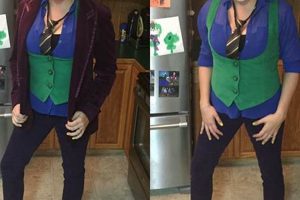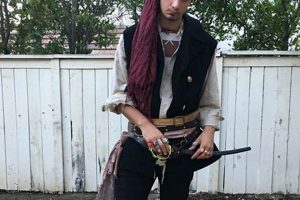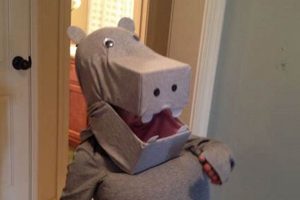Creating a homemade superhero outfit inspired by the Parr family from the animated film, The Incredibles, involves crafting a garment that replicates their distinctive red and black suits. This undertaking typically includes sourcing appropriate fabrics, such as stretch materials for a form-fitting design, and applying the recognizable “i” logo. An example would be parents constructing these costumes for their children for a themed birthday party or Halloween.
Constructing such attire offers several advantages, including cost savings compared to purchasing commercially available versions. Moreover, it allows for personalized customization regarding fit, material choice, and embellishments. Historically, the practice of making costumes at home reflects a broader trend of resourceful creativity and a desire for unique expression, often driven by budget constraints or a preference for handcrafted items.
The subsequent sections will delve into specific methods for fabricating various components of these superhero ensembles, encompassing fabric selection, emblem creation, pattern drafting, and assembly techniques. Detailed instructions and adaptable strategies will empower individuals to successfully execute their own versions.
DIY The Incredibles Costume
Constructing a satisfactory superhero suit necessitates careful planning and execution. The following tips are designed to improve the overall quality and durability of the final product.
Tip 1: Fabric Selection is Paramount: Opt for a four-way stretch fabric, such as spandex or athletic knit, to ensure a comfortable and form-fitting silhouette. Avoid fabrics with limited elasticity, as they may restrict movement and compromise the visual aesthetic.
Tip 2: Pattern Accuracy is Crucial: Utilize pre-existing patterns for bodysuits or create a custom pattern based on individual measurements. Precise pattern drafting minimizes fitting issues and reduces fabric waste.
Tip 3: Emblem Application Requires Precision: The “i” logo can be applied using heat transfer vinyl, fabric paint, or felt appliqus. Ensure the emblem is centered and securely attached to the chest of the garment. A template or stencil is recommended for accuracy.
Tip 4: Consider Reinforcements at Stress Points: Reinforce seams and areas subject to high stress, such as the crotch and underarms, with additional stitching or fusible interfacing. This enhances the garment’s longevity and prevents premature tearing.
Tip 5: Incorporate Functional Elements: Integrate concealed zippers or closures for ease of donning and doffing the suit. Strategic placement of these elements maintains the seamless appearance of the costume.
Tip 6: Pay Attention to Color Matching: Strive for accurate color matching between the red and black components of the suit. Discrepancies in color can detract from the overall authenticity of the design.
Tip 7: Accessorize Thoughtfully: Complete the ensemble with black gloves and boots or shoe covers. These accessories contribute to the overall cohesiveness and recognizability of the Incredibles aesthetic.
By adhering to these suggestions, the resulting superhero attire should be visually appealing, comfortable to wear, and durable for repeated use. The meticulous attention to detail will elevate the project from a simple craft to a respectable representation of the iconic characters.
The concluding section will offer guidance on adapting these principles for varying skill levels and exploring additional customization options.
1. Fabric elasticity
Fabric elasticity constitutes a crucial factor in the successful execution of a homemade Incredibles costume. The film’s character designs feature form-fitting superhero suits, necessitating the utilization of materials that exhibit significant stretch and recovery properties. Inadequate elasticity in the chosen fabric directly impacts the costume’s fit, comfort, and overall aesthetic. A fabric lacking sufficient stretch will create a baggy or restrictive garment, deviating from the intended sleek and athletic appearance.
The selection of a highly elastic fabric, such as spandex or a four-way stretch knit, allows for a close-fitting silhouette that conforms to the wearer’s body. This ensures freedom of movement, which is particularly relevant for children or individuals participating in activities while wearing the costume. Furthermore, the fabric’s recovery properties its ability to return to its original shape after being stretched prevent the suit from becoming misshapen or sagging over time. For example, a costume made with a non-stretch cotton blend will likely wrinkle and lose its shape quickly, whereas a spandex-based suit will maintain its form and appearance even after repeated wear.
Therefore, fabric elasticity is not merely a superficial consideration but a fundamental requirement for achieving a visually accurate and functionally suitable Incredibles costume. The correct material properties are directly linked to both the aesthetic appeal and the wearability of the finished product. Failure to prioritize this aspect compromises the entire project, resulting in a costume that falls short of its intended purpose. Understanding this connection provides a critical foundation for a successful DIY project.
2. Pattern precision
Accurate pattern drafting serves as a cornerstone in the creation of a successful homemade version of attire inspired by The Incredibles. Given the form-fitting nature of the characters’ suits, precise pattern creation is not merely advisable; it is a fundamental prerequisite. Errors in pattern dimensions directly translate into ill-fitting garments, detracting from the visual representation and compromising wearer comfort. For example, an incorrectly sized torso pattern will result in either a constricting or excessively loose suit, negating the intended streamlined aesthetic. The absence of pattern precision is often the primary cause of unsatisfactory results in such projects.
The implications of inaccurate patterns extend beyond mere aesthetics. Improperly fitted costumes can impede movement, particularly crucial for children engaged in play or individuals attending costume-related events. A sleeve pattern that is too narrow, for instance, will restrict arm mobility. Similarly, inaccurate leg patterns can affect stride length and overall comfort. Commercial patterns designed for generic clothing may not readily adapt to the specific requirements of superhero-style suits, necessitating either extensive alterations or the creation of custom patterns based on precise body measurements. This process demands a thorough understanding of pattern drafting principles and meticulous attention to detail.
In summation, pattern precision forms an inextricable link to the o
verall quality and usability of a homemade suit inspired by The Incredibles. Deviations from accurate pattern dimensions result in diminished visual fidelity, impaired wearer comfort, and restricted mobility. Prioritizing precise pattern drafting is essential for achieving a satisfactory and functional garment. While challenges may arise in adapting existing patterns or creating new ones, the investment in accuracy demonstrably enhances the final outcome, transforming a simple craft endeavor into a commendable replica of the iconic superhero apparel.
3. Emblem accuracy
The iconic “i” emblem is a defining characteristic of the suits worn by the characters from The Incredibles. When undertaking a homemade version of this attire, emblem accuracy assumes paramount importance. A poorly executed emblem significantly diminishes the recognizability and overall visual impact of the costume.
- Shape and Proportions
The “i” emblem’s distinctive shape is critical. Deviations from the proper rounded form and proportional dimensions result in a less authentic appearance. For instance, an emblem that is too elongated or has excessively sharp corners will detract from the established design. Precise adherence to the original shape and proportions is necessary for faithful replication.
- Color Fidelity
The color of the emblem, typically rendered in a vibrant orange-yellow hue, must accurately match the established color palette. Variations in color, such as a muted or overly saturated tone, compromise the overall visual harmony of the costume. Employing color-matching techniques or referencing official artwork ensures accurate color representation. Fabric stores often provide color matching to ensure accuracy.
- Placement Precision
The emblem’s placement on the chest of the suit requires precision. Centering the emblem vertically and horizontally is essential for a balanced and visually appealing composition. Misaligned emblems, positioned too high, too low, or off-center, create a jarring and unprofessional appearance. Proper measurements and the use of guides or templates facilitate accurate placement.
- Application Technique
The method used to apply the emblem affects its durability and visual integrity. Heat transfer vinyl, fabric paint, and felt appliqus represent common application options. Each technique presents its own challenges and benefits. Regardless of the chosen method, secure adhesion and a clean, crisp finish are necessary. Peeling or poorly applied emblems detract from the overall quality of the costume. A proper application can ensure the costume lasts long enough and still looks good.
Each facet contributes to the final appearance of a homemade Incredibles inspired garment. A lack of attention to any individual part will result in diminished quality. A costume with a well-constructed suit, for example, may be marred by an inaccurate rendering, thus impacting the final product, leading to a disappointing result.
4. Seam reinforcement
Seam reinforcement represents a critical, though often overlooked, aspect of constructing a durable and aesthetically pleasing superhero costume inspired by The Incredibles. The form-fitting nature and potential for active use necessitate robust seam construction to prevent tearing and ensure longevity.
- Stress Point Identification
Certain areas of a garment experience disproportionately high stress levels. In the context of a superhero suit, these typically include the crotch, underarms, and joints. Reinforcing seams in these regions mitigates the risk of seam failure during movement or activity. For example, a gusset inserted at the crotch distributes stress more evenly, reducing strain on the primary seams.
- Stitch Selection and Density
The choice of stitch type and density directly impacts seam strength. A straight stitch, while commonly used, may not provide sufficient resilience for a form-fitting garment subjected to stretching. Zigzag stitches or overlock stitches offer greater elasticity and resistance to tearing. Increasing the stitch density, measured in stitches per inch, further enhances seam durability. An overlock stitch, for example, encases the raw edges of the fabric, preventing fraying and adding strength.
- Reinforcement Materials
Supplementary materials can augment seam strength. Fusible interfacing, applied to the wrong side of the fabric along the seam line, provides additional support and prevents stretching. Reinforcement tape, sewn along the seam line, offers similar benefits. For high-stress areas, consider using a heavier-weight thread or multiple rows of stitching. The use of interfacing around zipper areas is common practice in ensuring a strong seam.
- Seam Finishing Techniques
Properly finishing seam allowances prevents fraying and unraveling, which can weaken the overall seam structure. Techniques such as serging, zigzag stitching, or binding the seam allowances with bias tape protect the raw edges of the fabric and contribute to a more professional and durable finish. The inclusion of binding tape along a neckline seam, for instance, can stop stretching and reinforce the seam.
Integrating these seam reinforcement techniques into the construction process enhances the resilience and longevity of a homemade Incredibles costume. The investment in robust seam construction translates to a garment capable of withstanding repeated wear and activity, representing a valuable consideration for cost-effectiveness and overall satisfaction. Neglecting seam reinforcement is often a false economy, leading to premature garment failure and the need for costly repairs or replacements.
5. Closure functionality
Closure functionality is an integral component when creating a homemade superhero suit inspired by The Incredibles. The practical design of a form-fitting garment necessitates a means of entry and exit, directly influencing the ease of donning and removing the costume. The effectiveness of the chosen closure mechanism has a cascading effect on the user experience, impacting comfort, convenience, and the overall usability of the resulting attire. Ill-conceived closures render the costume cumbersome, potentially deterring its use or even causing damage during attempts to put it on or take it off. A strategically placed and functional closure system, conversely, ensures a seamless and efficient experience.
Examples of functional closures in a DIY superhero suit include strategically positioned zippers, hook-and-loop fasteners (such as Velcro), or snap closures. Zippers, often concealed along the back or side seams, offer a secure and relatively invisible closure. Hook-and-loop fasteners provide adjustability and ease of use, particularly suitable for areas requiring a less permanent closure. Snap closures, while less common in form-fitting suits, can be effective for securing accessories or detachable components. The choice of closure depends o
n the specific design of the costume, the wearer’s age and dexterity, and the desired level of visual integration. Improper selection or installation of a closure mechanism can lead to garment stress, seam damage, or even closure failure. A zipper that is too short or poorly aligned, for example, may become difficult to operate or prone to breakage.
In conclusion, closure functionality significantly affects the practicality and user-friendliness of a homemade Incredibles costume. The thoughtful selection and precise implementation of a suitable closure system are essential for ensuring ease of use, garment integrity, and overall wearer satisfaction. Challenges in this area often stem from balancing aesthetic considerations with functional requirements, necessitating careful planning and execution. Prioritizing closure functionality transforms a visually appealing costume into a comfortable and practical garment, thereby enhancing its value and usability.
6. Color consistency
Maintaining color consistency is paramount when crafting a homemade garment based on The Incredibles. The superhero family’s suits are defined by a specific color palette primarily red and black and any deviation from these established hues diminishes the costume’s authenticity and visual impact. Color inconsistency can arise from various sources during the construction process, necessitating careful attention to detail and strategic decision-making.
- Fabric Matching
Achieving identical shades of red and black across different fabric types is a significant challenge. Spandex, athletic knits, and woven materials absorb dye differently, potentially resulting in subtle variations in color intensity and tone. Sourcing all fabrics from the same manufacturer or utilizing dye lots to ensure uniformity can mitigate this issue. Comparing fabric swatches under consistent lighting conditions is also advisable. A slight variation of shades can make the final output unappealing to the eyes.
- Emblem and Accent Color Accuracy
The “i” emblem, typically rendered in an orange-yellow hue, must align with the official color specifications. Similarly, any accent colors, such as the black gloves and boots, should adhere to a consistent shade of black. Discrepancies in these secondary colors can detract from the overall cohesive design. Color charts and digital color palettes provide valuable references for achieving accuracy. Failure to meet with accuracy may make the entire attire not authentic.
- Lighting Influence on Perception
Color perception is influenced by ambient lighting. The red fabric that appears consistent under indoor lighting may exhibit variations when viewed in natural sunlight. Considering the intended environment where the costume will be worn is crucial for selecting fabrics that maintain their color fidelity across different lighting conditions. Taking a swatch of the fabrics into the environments is an essential step.
- Dyeing and Painting Techniques
If matching pre-dyed fabrics proves impossible, dyeing or painting represents viable alternatives. However, these techniques require careful execution to ensure even color distribution and prevent streaking or blotchiness. Using high-quality dyes or paints specifically formulated for the chosen fabric is essential. Testing the chosen dye or paint on a scrap piece of fabric is highly recommended before applying it to the final garment, to ensure the colour is what is expected.
The pursuit of color consistency underscores the importance of meticulous planning and execution when creating a homemade costume inspired by The Incredibles. Addressing potential sources of color variation and implementing appropriate mitigation strategies ensures that the final product accurately reflects the established aesthetic, thereby enhancing its authenticity and visual impact. Failure to address color consistency can significantly detract from the overall success of the project, irrespective of other construction techniques.
7. Accessory selection
The deliberate selection of accessories exerts a tangible influence on the overall effectiveness of a do-it-yourself Incredibles costume. While the primary garment, replicating the red and black suit, constitutes the core of the ensemble, accessories provide critical finishing touches that elevate the costume from a simple imitation to a recognizable representation of the characters. The absence of carefully considered accessories can diminish the visual impact of an otherwise well-constructed suit, while appropriate additions enhance authenticity and contribute to a more convincing portrayal. This cause-and-effect relationship underscores the importance of accessory selection as an integral component of the project.
Real-life examples serve to illustrate this point. Black gloves, mirroring the attire of several members of the Parr family, contribute significantly to the costume’s aesthetic. Similarly, black boots or shoe covers, designed to resemble the characters’ footwear, complete the streamlined silhouette. Masks or eye coverings, while optional, further enhance the illusion, particularly for characters like Frozone, who frequently appears with eyewear. The incorporation of these elements, tailored to the specific character being emulated, demonstrates a commitment to detail that distinguishes a rudimentary attempt from a more refined and believable rendition. In practical terms, understanding this connection empowers individuals to make informed decisions about which accessories are essential versus optional, optimizing both cost and effort.
In summary, the accessories chosen when crafting a homemade Incredibles costume are not mere embellishments, but rather critical elements that contribute substantially to its overall success. The selection process requires careful consideration of the characters’ established appearance, as well as a practical assessment of budget and construction capabilities. By prioritizing accessory selection, individuals can overcome the challenge of creating a truly convincing costume and achieve a level of authenticity that elevates their project from a simple craft activity to a compelling representation of the beloved characters. The understanding of this interplay between the primary garment and the adjunct items makes the whole project successful.
Frequently Asked Questions
This section addresses common inquiries and potential challenges encountered when constructing a homemade superhero suit inspired by The Incredibles. The information provided aims to clarify technical aspects and offer practical solutions for a successful outcome.
Question 1: What is the most suitable fabric for replicating the form-fitting nature of the Incredibles’ suits?
Spandex or a four-way stretch knit fabric is generally recommended. These materials provide the necessary elasticity for a close fit while allowing for freedom of movement. Alternatives with less stretch may compromise both the aesthetic and functional aspects of the costume.
Question 2: How can emblem accuracy be ensured when replicating the iconic “i” logo?
Employing a template or stencil is advised for maintaining consistent shape and proportions. Heat transfer vinyl, fa
bric paint, or felt appliqus can be utilized for application, ensuring precise placement and secure adhesion. Digital resources often provide accurate renderings of the logo for reference.
Question 3: What are effective methods for reinforcing seams, particularly in high-stress areas?
Zigzag or overlock stitches offer greater elasticity and resistance to tearing compared to straight stitches. Applying fusible interfacing to the wrong side of the fabric along the seam line provides additional support. Reinforcement tape can also be sewn along the seam line for enhanced durability.
Question 4: What are the advantages and disadvantages of different closure options, such as zippers, hook-and-loop fasteners, and snaps?
Zippers offer a secure and relatively invisible closure but may require precise alignment. Hook-and-loop fasteners provide adjustability and ease of use but may be less visually integrated. Snap closures are suitable for securing accessories or detachable components but may not be ideal for form-fitting areas.
Question 5: How can color consistency be achieved when sourcing fabrics from different suppliers?
Attempting to source all fabrics from the same manufacturer or utilizing dye lots is recommended. Comparing fabric swatches under consistent lighting conditions is essential. Dyeing or painting fabrics to achieve a uniform color is an alternative, but requires careful execution.
Question 6: What are some essential accessories for completing the Incredibles costume, and how can they be effectively incorporated?
Black gloves and boots or shoe covers are essential for replicating the characters’ attire. Masks or eye coverings may be included for specific characters. Prioritizing accessories that complement the overall design and contribute to the recognizability of the costume is crucial.
Careful consideration of these questions and implementation of the suggested strategies can significantly improve the quality and durability of a homemade costume. Attention to detail and a proactive approach to problem-solving are essential for a successful project.
The subsequent section will provide concluding remarks and offer additional resources for further exploration.
DIY The Incredibles Costume
The preceding discussion has explored various facets of creating a homemade garment inspired by the Parr family attire, specifically focusing on fabric selection, pattern drafting, emblem creation, seam reinforcement, closure mechanisms, color consistency, and accessory choices. Emphasis has been placed on the interplay between these elements and their cumulative impact on the resulting costume’s visual fidelity, durability, and overall functionality. Attention to each aspect is crucial for project success.
The information presented is intended to empower individuals to approach this endeavor with a comprehensive understanding of the challenges and opportunities involved. While the act of replicating a fictional design inherently requires resourcefulness and adaptability, adherence to fundamental principles of garment construction and a meticulous approach to detail can significantly elevate the outcome. The value of a well-executed project extends beyond its aesthetic appeal, fostering a sense of accomplishment and potentially inspiring further creative exploration.







